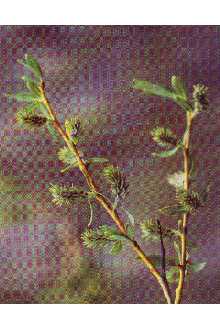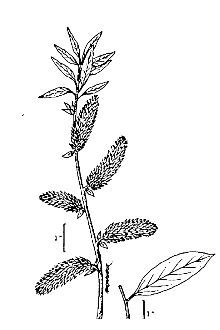Salix lemmonii Bebb var. melanopsis Bebb
Scientific Name: Salix lemmonii Bebb var. melanopsis Bebb

| General Information | |
|---|---|
| Usda Symbol | SALEM2 |
| Group | Dicot |
| Life Cycle | Perennial |
| Growth Habits | Shrub |
| Native Locations | SALEM2 |
Plant Guide
Alternate Names
Lemmon willow
Uses
Reclamation: Lemmon's willow is used for revegetation of riparian areas, native plant community restoration and landscaping. Livestock and Wildlife: All classes of livestock eat willows in the West, but cattle consume more than others because they frequent riparian areas. Lemmon's willow is palatable to livestock, but its importance in their diets is not reported. Deer and elk use Lemmon's willow for browse. Beavers prefer willows as food and building material. Ducks and grouse, other birds and small mammals eat willow shoots, catkins, buds and leaves. Lemmon's willow provides good cover for mammals and songbirds and provides shade for salmonids. Ethnobotany: Native Americans and others have long used willows for basket making. Willows are also a well-known source of salacin, which is chemically related to aspirin. Willows have also been used by Native Americans for bows, arrows, scoops, fish traps, and other items.
Status
Please consult the PLANTS Web site and your State Department of Natural Resources for this plant’s current status (e.g. threatened or endangered species, state noxious status, and wetland indicator values). W. Crowder USDA NRCS Pullman Plant Materials Center Pullman, WA
Description
General: Lemmon's willow is a multi-stemmed native deciduous shrub, It reaches a mature height of 10 - 16 feet, Flowers appear before or with new leaves, Leaves are alternate, pinnate-veined, entire or inconspicuously toothed, green shiny above and pale glaucous below, Stipules are minute and inconspicuous, Current season twigs are glabrous or sparsely pubescent, becoming strongly glaucous, Distribution: Lemmon's willow occurs in foothills to mid-mountains from Hood River County, Oregon along the east side of the Cascades to the Sierras in California east to Owyhee County, Idaho and Nevada, For current distribution, please consult the Plant Profile page for this species on the PLANTS Web site, Use soil moisture sensors to measure the soil moisture of Salix lemmonii Bebb var. melanopsis Bebb., Habitat: Lemmon's willow occurs in riparian habitats which are usually bordered by coniferous forests of lodgepole pine (Pinus contorta) or Douglas fir (Pseudotsuga menziesii), It also occurs in zones of mountain big sagebrush (Artemisia tridentata ssp, vaseyana), It grows near low gradient streams and rivers on floodplains, It is probably an early seral species as are many other willows, Associated Species: Associated shrubs include Geyer (S, geyeriana), Drummond (S, drummondiana) planeleaf (S, planifolia) and Wolf willow (S, wolfii), Bog birch (Betula glandulosa) and Kentucky bluegrass (Poa pratense) are also common,
Adaptation
Lemmon's willow is found on well-drained gravelly or sandy soils. In Oregon, it is found on deep, fine-textured alluvium over subsurface soils of various textures ranging from silt to silty clay loam soil. Soil pH ranges from 5.2 to 7.4 and annual precipitation requirement is from 20 to 40 inches. Shade tolerance is intermediate.
Establishment
Lemmon's willow may be propagated via seed or cuttings. Seed is used to produce containerized plants. Cuttings may either be planted directly at the site or planted to produce bareroot or containerized plants. On-site wild hardwood cutting collections may not root as well as nursery grown stock. Nursery grown cuttings' growing conditions are maintained at a more optimum level, therefore the cuttings have better carbohydrate storage levels and less potential problems with disease and insects. Lemmon's willow should be established in the capillary zone in riparian revegetation plantings. Plantings should be protected with appropriate physical barriers such as wire cages or tree protector tubes where there is rodent or beaver activity. Much information is available for willow establishment, primarily in riparian zones. See reference section.
Management
Lemmon's willow provides important streambank protection by effectively stabilizing soils. Heavy grazing in Lemmon's willow communities can lead to lowered vigor, uneven stem age distribution and dead clumps. Plants recover rapidly when browsing is excluded. Grazing is particularly detrimental to the establishment of willows.
Pests and Potential Problems
Poplar/willow borers are potential problems in stands of Lemmon's willow maintained for cutting production. Borers must be controlled prior to entering the stems. Decadent stems with borer infestation should be pruned from commercial cutting production sites. Consult local/state pesticide recommendations for further control. Willows plantings, especially during establishment, can be damaged by rodents including beaver, muskrat, mice, voles, etc. either cutting off or girdling stems. Cuttings or plants should be protected from rodent damage, especially in grassy areas where vole/mice populations are active.
Seed and Plant Production
Plant Production
Plant Production
Lemmon's willow is easily propagated by use of hardwood cuttings without use of rooting hormone. Seed propagation is also used, but seed must be collected as soon as the fruits ripen. Mature seed loses germination ability rapidly, so planting soon after collection is necessary. Moistened seed may be stored for up to a month in refrigerated sealed containers. Seeds of willow are not generally known to exhibit dormancy. Some native plant propagators prefer seed propagation for added diversity of genetic material and less labor requirement for handling of materials during collection, storage and propagation. (See reference section for production of hardwood cuttings in cutting blocks or stooling beds.) Cultivars, Improved and Selected Materials 'Palouse' Lemmon's willow was released as a cultivar by the NRCS Pullman, Washington Plant Materials Center in 1993. "Palouse' originated from a riparian site near the Crooked River in Jefferson County, Oregon northwest of Redmond at an elevation of 2500 feet. Mature height is 19.7 feet and canopy width is 36.1 feet at Pullman, Washington. 'Palouse' is relatively fast growing, reaching a height of 13.1 feet and canopy width of 11.5 feet in 3 years of growth at Pullman, Washington. 'Palouse' has excellent foliage density. It easily roots from hardwood cuttings without use of rooting hormone treatment. Recorded rooting rate in one study was 85%. Six year old plants produced 522 6-inch hardwood cuttings per plant after being cut back. Production the following year was 225 cuttings per plant. 'Palouse' is available commercially. Contact your local Natural Resources
Conservation
Service (formerly Soil Conservation Service) office for more information. Look in the phone book under ”United States Government.” The Natural Resources Conservation Service will be listed under the subheading “Department of Agriculture.”
Plant Traits
Growth Requirements
| Temperature, Minimum (°F) | -28 |
|---|---|
| Adapted to Coarse Textured Soils | Yes |
| Adapted to Fine Textured Soils | Yes |
| Adapted to Medium Textured Soils | Yes |
| Anaerobic Tolerance | Low |
| CaCO3 Tolerance | Medium |
| Cold Stratification Required | No |
| Drought Tolerance | Low |
| Fertility Requirement | Medium |
| Fire Tolerance | High |
| Frost Free Days, Minimum | 110 |
| Hedge Tolerance | Medium |
| Moisture Use | High |
| pH, Maximum | 7.4 |
| pH, Minimum | 5.2 |
| Planting Density per Acre, Maxim | 2700 |
| Planting Density per Acre, Minim | 1200 |
| Precipitation, Maximum | 40 |
| Precipitation, Minimum | 20 |
| Root Depth, Minimum (inches) | 20 |
| Salinity Tolerance | None |
| Shade Tolerance | Intermediate |
Morphology/Physiology
| Bloat | None |
|---|---|
| Toxicity | None |
| Resprout Ability | Yes |
| Shape and Orientation | Erect |
| Active Growth Period | Spring and Summer |
| C:N Ratio | High |
| Coppice Potential | Yes |
| Fall Conspicuous | No |
| Fire Resistant | No |
| Flower Color | Yellow |
| Flower Conspicuous | No |
| Foliage Color | Green |
| Foliage Porosity Summer | Dense |
| Foliage Porosity Winter | Moderate |
| Fruit/Seed Conspicuous | No |
| Nitrogen Fixation | None |
| Low Growing Grass | No |
| Lifespan | Long |
| Leaf Retention | No |
| Known Allelopath | No |
| Height, Mature (feet) | 14.0 |
| Height at 20 Years, Maximum (fee | 14 |
| Growth Rate | Rapid |
| Growth Form | Multiple Stem |
| Foliage Texture | Medium |
Reproduction
| Vegetative Spread Rate | None |
|---|---|
| Small Grain | No |
| Seedling Vigor | Low |
| Seed Spread Rate | Slow |
| Fruit/Seed Period End | Summer |
| Propagated by Tubers | No |
| Propagated by Sprigs | No |
| Propagated by Sod | No |
| Propagated by Seed | Yes |
| Propagated by Cuttings | Yes |
| Propagated by Container | Yes |
| Propagated by Bulb | No |
| Propagated by Bare Root | Yes |
| Fruit/Seed Persistence | No |
| Fruit/Seed Period Begin | Spring |
| Fruit/Seed Abundance | Low |
| Commercial Availability | Contracting Only |
| Bloom Period | Early Spring |
| Propagated by Corm | No |
Suitability/Use
| Veneer Product | No |
|---|---|
| Pulpwood Product | No |
| Post Product | No |
| Palatable Human | No |
| Palatable Graze Animal | Low |
| Palatable Browse Animal | Medium |
| Nursery Stock Product | No |
| Naval Store Product | No |
| Lumber Product | No |
| Fodder Product | No |
| Christmas Tree Product | No |
| Berry/Nut/Seed Product | No |

